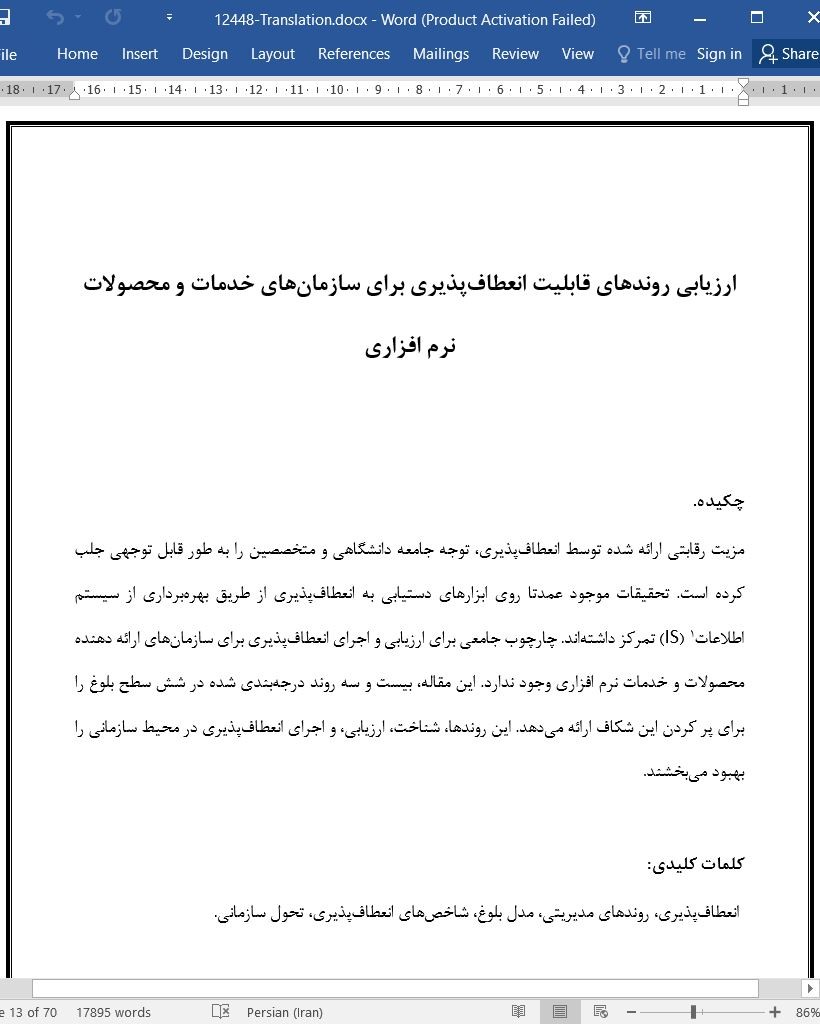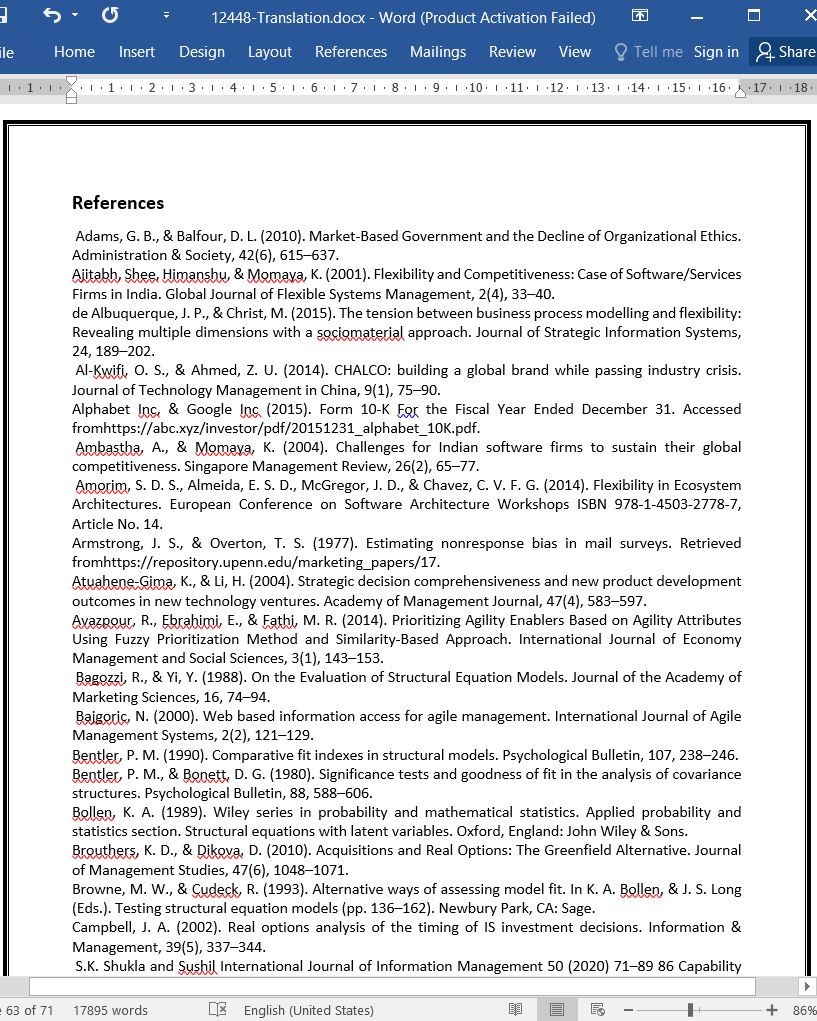
دانلود مقاله ارزیابی روندهای قابلیت انعطاف پذیری برای سازمان های خدمات و محصولات نرم افزاری
چکیده
مزیت رقابتی ارائه شده توسط انعطافپذیری، توجه جامعه دانشگاهی و متخصصین را به طور قابل توجهی جلب کرده است. تحقیقات موجود عمدتا روی ابزارهای دستیابی به انعطافپذیری از طریق بهرهبرداری از سیستم اطلاعات (IS) تمرکز داشتهاند. چارچوب جامعی برای ارزیابی و اجرای انعطافپذیری برای سازمانهای ارائه دهنده محصولات و خدمات نرم افزاری وجود ندارد. این مقاله، بیست و سه روند درجهبندی شده در شش سطح بلوغ را برای پر کردن این شکاف ارائه میدهد. این روندها، شناخت، ارزیابی، و اجرای انعطافپذیری در محیط سازمانی را بهبود میبخشند.
1. مقدمه
تحقیقات موجود عمدتا به بررسی انعطافپذیریهای انتخاب، از قبیل انعطافپذیری ماشین، انعطافپذیری مالی، انعطافپذیری منابع انسانی، و غیره پرداختهاند. مکانیسمهای موجود ارزیابی انعطافپذیری، در سازمانها و بخشهای صنعت، متفاوت هستند. دیدگاههای مختلفی در مورد پیامدهای انواع مشابه انعطافپذیری در طول صنایع وجود دارند. این چندگانی دیدگاهها منجر به قابلیت اجرای ضعیف و ناسازگاری در تفسیر نتایج ارزیابی انعطافپذیری شده و به شدت محدود به تفکرات آکادمیک است. تحقیقات موجود، انعطافپذیری را از چشماندازی میکرو میبینند و به ارزیابی انواع مختلف انعطافپذیری سازمانی میپردازند. چارچوب جامعی برای ارزیابی انعطافپذیری از چشمانداز ماکرو وجود ندارد، که این امر منجر به تصمیمات و برنامهریزیهای سازمانی میشود که این ابزار راهبردی مهم را نادیده میگیرند.
مطالعات محدودی وجود دارند که انعطافپذیریهای برای سازمانیهای فناوری اطلاعات (IT) ارائه دهنده محصولات و خدمات نرمافزاری را که حوزه بررسی این مقاله است را ارزیابی میکنند. در بخشهای دیگر صنعت نیز با کمبود تحقیقات در زمینه شیوه جامعی برای اجرای انعطافپذیری مواجه هستیم. وضعیت موجود، چالشی را در زمینه استانداردسازی رویکرد ارزیابی انعطافپذیری ارائه میدهد، که میتوان از آن برای پیشرفت این رویکرد استفاده کرد. در این مقاله، با شناسایی روندهای استانداردی که منجر به مفهومسازی مدل بلوغ انعطافپذیری (FMM) برای سازمانهای IT میشوند به بررسی این چالش میپردازیم. مدل بلوغ انعطافپذیری پنج مرحلهای با توسعه تعریف سطوح بلوغ «قابلیت یکپارچهسازی مدل بلوغ برای نسخه توسعه » (CMMI-DEV؛ V1.3، ۲۰۱۰) در خدمات حرفهای شرکتهای قانونی توسط رویمان (۲۰۱۰) مفهومسازی شده است. مفهومسازی FMM برای سازمانهای خدمات و محصولات در بخش IT، فرصتی را برای بررسی این مفهوم به شیوهای جدید و بیطرفانه ارائه میدهد.
10. نتیجهگیری
این روندهای بلوغ انعطافپذیری، نتیجه چشمانداز ماکرو هستند؛ این روندها شناخت و پیادهسازی انعطافپذیری در محیطهای سازمانی را بسیار راحتتر خواهند ساخت، و به موجب آن منجر به عملکرد پایدار میشوند. این تحقیق، چشمانداز جدیدی از انعطافپذیری را برای مدیران و محققان فعال در توسعه نرمافزار فراهم میسازد. این مقاله، مساله ارزیابی بلوغ انعطافپذیری را با افزودن روندهای متناظر با سطوح بلوغ انعطافپذیری مورد بررسی قرار میدهد. سازمانها باید سطح بلوغ موجود خود را به دقت بررسی کرده و سعی در بهبود روندهای انتخابی یا شاخصهایی داشته باشند که عملکرد سازمانی را بهبود خواهند بخشید.
تقویت روندهای سطح پایینتر منجر به عملکرد فرایند میشود و تقویت روندهای سطح بلوغ بالاتر منجر به ایجاد تاثیر گستردهتری روی جامعه و دولت میشود. ویژگیهای بالاترین سطح بلوغ، این الزام را ایجاد میکنند که سازمان باید در مقیاس جهانی فعالیت داشته باشد. فعال کنندگان شدید و بالغ در همه کرهها، با شروع از محصول، فرایند، سازمان، صنعت، جامعه و دولت، در بالاترین سطوح بلوغ انعطافپذیری در نظر گرفته میشوند و برای عملکرد اکوسیستم ضروری هستند. این، چارچوب مبنا برای فرمولبندی FMM در هر بخش صنعتی است.
Abstract
The competitive advantage offered by flexibility has drawn considerable attention from the academic and practitioner community. The existing literature primarily focuses on means to achieve flexibility through information system (IS) exploitation. There is a noticeable absence of a comprehensive flexibility evaluation and implementation framework for organizations, engaged in the delivery of software products and services. This paper proposes twenty-three practices graded in six maturity levels to fill this gap. These practices will improve the understanding, evaluation, and implementation of flexibility in the organizational setting.
1. Introduction
The extant literature primarily deals with measuring select flexibilities, e.g., machine flexibility, financial flexibility, human resource flexibility, etc. The available mechanisms of flexibility evaluation are different across organizations and industry sectors. There are multiple views of outcomes of similar types of flexibility across industries. This multiplicity of views causes poor applicability and inconsistency in the interpretation of the results of flexibility evaluation, and largely limited to academic contemplations. The existing literature views the flexibility from a micro perspective and evaluates different types of organizational flexibility. There is a noticeable absence of a comprehensive flexibility evaluation framework from a macro perspective, which results in organizational planning and decisions that ignore this important strategic tool.
There is a limited study of the evaluation of flexibilities for information technology (IT) organizations delivering software products and services which is the current scope of this paper. In the other industry sectors also, there is a dearth of literature for comprehensive treatment for flexibility. The present situation presents a challenge to the standardization of the flexibility evaluation approach, which could also be used to guide its enhancement. This challenge has been addressed in this paper by identifying the standardized practices that lead to the conceptualization of flexibility maturity model (FMM) for IT organizations. Five-phase flexibility maturity model extending the definition of maturity levels of Capability Maturity Model Integration for Development Version (CMMI-DEV, V1.3) (2010) in professional services of law firms has been conceptualized by Rooymans (2010). The conceptualization of FMM for product and services organization in IT sector provides an opportunity to explore the concept in a novel and neutral manner.
10. Conclusion
These practices of flexibility maturity are the result of the macro perspective; it will make understanding and implementation of flexibility in organizational settings much easier, resulting in sustained performance. This research provides a fresh perspective of flexibility to managers and scholars working in software development. This paper addresses the problem of flexibility maturity evaluation by adding the practices that correspond to flexibility maturity levels. Organizations should carefully assess their existing maturity level and try to improve select practices or indicators that will improve organizational performance.
The strengthening of lower-level practices results in process performance, and the strengthening of higher maturity level practices results in the creation of a wider impact on society and government. The characteristics of the highest maturity level mandates that the organization should be operating on a global scale. The intense and matured enablers in all spheres, starting with product, process, organization, industry, society, and government, are considered to be at the highest flexibility maturity levels are required for ecosystem performance. This is a base framework for formulating FMM for any industrial sector.
چکیده
1. مقدمه
2. مرور تحقیقات و پیشزمینه نظری
2.1. شاخصهای اولین سطح بلوغ انعطافپذیری
2.2. شاخصهای دومین سطح بلوع انعطافپذیری
2.3. شاخصهای سومین سطح بلوغ انعطافپذیری
2.4. شاخصهای چهارمین سطح بلوغ انعطافپذیری
2.5. شاخصهای پنجمین سطح بلوغ انعطافپذیری
2.6. شاخصهای ششمین سطح بلوغ انعطافپذیری
3. روشهای تحقیق
3.1. پروفایلهای پاسخ دهندگان
3.2. تجزیه و تحللی عاملی (EFA و CFA)
3.3. مصاحبه دو مرحلهای
4. نتایج تجزیه و تحلیل عاملی و مصاحبهها
4.1. نتایج تجزیه و تحلیل عاملی توضیحی مربوط به روندها
4.2. معتبرسازی روندها با استفاده از تجزیه و تحلیل عاملی تاییدی
4.3. نتایج مصاحبهها
5. ترکیب یافتهها
6. بحث
7. توصیهها
7.1. توصیهها و شواهد مربوط به استفاده از شاخصها و روندهای بلوغ انعطافپذیری سطح ۱
7.2. توصیهها و شواهد استفاده از شاخصها و روندهای بلوغ انعطافپذیری سطح ۲
7.3. توصیهها و شواهد استفاده از شاخصها و روندهای بلوغ انعطافپذیری سطح ۳
7.4. توصیهها و شواهد استفاده از شاخصها و روندهای بلوغ انعطافپذیری سطح ۴
7.5. توصیهها و شواهد استفاده از روندها و شاخصهای بلوغ انعطافپذیری سطح ۵
7.6. توصیهها و شواهد استفاده از روندها و شاخصهای بلوغ انعطافپذیری در سطح ۶
8. پیامدهای تحقیق
8.1. پیامدهای برای روند
8.2. کمک به نظریه IS و تحقیقات
8.3. پیامدهای برای خطمشی
9. انعطافپذیری، رقابتی بودن، و عملکرد پایدار
10. نتیجهگیری
11. محدودیتها و کارهای آینده
منابع
ABSTRACT
1. Introduction
2. Literature review and theoretical background
2.1. Indicators of first flexibility maturity level
2.2. Indicators of second flexibility maturity level
2.3. Indicators of third flexibility maturity level
2.4. Indicators of fourth flexibility maturity level
2.5. Indicators of fifth flexibility maturity level
2.6. Indicators of sixth flexibility maturity level
3. Research Methods
3.1. Profiles of respondents
3.2. Factor analysis (EFA and CFA)
3.3. Two-phase interview
4. Results of factor analysis and Interviews
4.1. Results of exploratory factor analysis leading to practices
4.2. Validation of practices using confirmatory factor analysis
4.3. Results of interviews
5. Synthesis of findings
6. Discussion
7. Recommendations
7.1. Recommendation and Evidence of use of indicators and practices of flexibility maturity level-1
7.2. Recommendation and Evidence of use of indicators and practices of flexibility maturity level-2
7.3. Recommendation and Evidence of use of indicators and practices of flexibility maturity level-3
7.4. Recommendation and Evidence of use of indicators and practices of flexibility maturity level-4
7.5. Recommendation and Evidence of use of indicators and practices of flexibility maturity level-5
7.6. Recommendation and Evidence of use of indicators and practices of flexibility maturity level-6
8. Implications of research
8.1. Implications for practice
8.2. Contribution to IS theory and literature
8.3. Implications for policy
9. Flexibility, competitiveness and sustained performance
10. Conclusion
11. Limitations and future work
References
- اصل مقاله انگلیسی با فرمت ورد (word) با قابلیت ویرایش
- ترجمه فارسی مقاله با فرمت ورد (word) با قابلیت ویرایش، بدون آرم سایت ای ترجمه
- ترجمه فارسی مقاله با فرمت pdf، بدون آرم سایت ای ترجمه



